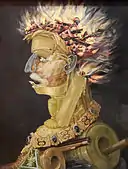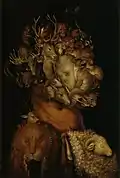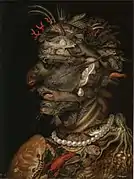Classical element
Classical elements typically refer to earth, water, air, fire, and (later) aether which were proposed to explain the nature and complexity of all matter in terms of simpler substances.[1][2] Ancient cultures in Greece, Tibet, and India had similar lists which sometimes referred, in local languages, to "air" as "wind" and the fifth element as "void".
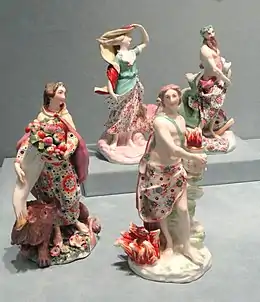
| Classical elements |
|---|
|
Stoicheion (στοιχεῖον) |
|
Tattva / Panchikarana / Pancha Bhoota / Mahābhūta |
|
Wuxing (五行) |
|
Godai (五大) |
|
Alchemy |
These different cultures and even individual philosophers had widely varying explanations concerning their attributes and how they related to observable phenomena as well as cosmology. Sometimes these theories overlapped with mythology and were personified in deities. Some of these interpretations included atomism (the idea of very small, indivisible portions of matter), but other interpretations considered the elements to be divisible into infinitely small pieces without changing their nature.
While the classification of the material world in ancient Indian, Hellenistic Egypt, and ancient Greece into Air, Earth, Fire and Water was more philosophical, during the Islamic Golden Age medieval middle eastern scientists used practical, experimental observation to classify materials.[3] In Europe, the Ancient Greek concept, devised by Empedocles, evolved into the system of Aristotle, which evolved slightly into the medieval system, which for the first time in Europe became subject to experimental verification in the 1600s, during the Scientific Revolution.
Modern science does not support the classical elements as the material basis of the physical world. Atomic theory classifies atoms into more than a hundred chemical elements such as oxygen, iron, and mercury. These elements form chemical compounds and mixtures, and under different temperatures and pressures, these substances can adopt different states of matter. The most commonly observed states of solid, liquid, gas, and plasma share many attributes with the classical elements of earth, water, air, and fire, respectively, but these states are due to similar behavior of different types of atoms at similar energy levels, and not due to containing a certain type of atom or a certain type of substance.
Hellenistic philosophy
| Aristotelian elements and qualities |
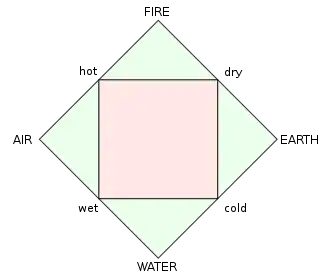 Four classical elements Empedoclean elements
|
The ancient Greek concept of four basic elements, these being earth (γῆ gê), water (ὕδωρ hýdōr), air (ἀήρ aḗr), and fire (πῦρ pŷr), dates from pre-Socratic times and persisted throughout the Middle Ages and into the Renaissance, deeply influencing European thought and culture.[4]
Pre-Socratic elements
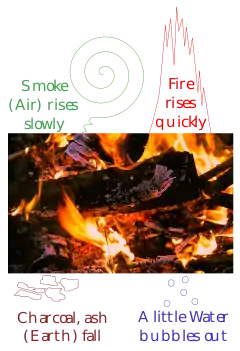
The Sicilian Greek philosopher Empedocles (c. 450 BC) proved (at least to his satisfaction) that air was a separate substance by observing that a bucket inverted in water did not become filled with water, a pocket of air remaining trapped inside.[5] Prior to Empedocles, Greek philosophers had debated which substance was the arche ("first principle"), or primordial element from which everything else was made; Heraclitus championed fire, Thales supported water, and Anaximenes plumped for air.[6] Anaximander argued that the primordial substance was not any of the known substances, but could be transformed into them, and they into each other.[7][4] Empedocles was the first to propose four elements, fire, earth, air, and water.[8] He called them the four "roots" (ῥιζώματα, rhizōmata).
Plato
Plato seems to have been the first to use the term "element (στοιχεῖον, stoicheîon)" in reference to air, fire, earth, and water.[9] The ancient Greek word for element, stoicheion (from stoicheo, "to line up") meant "smallest division (of a sun-dial), a syllable", as the composing unit of an alphabet it could denote a letter and the smallest unit from which a word is formed.
Humorism
According to Galen, these elements were used by Hippocrates in describing the human body with an association with the four humours: yellow bile (fire), black bile (earth), blood (air), and phlegm (water). Medical care was primarily about helping the patient stay in or return to his/her own personal natural balanced state.[10]
Aristotle
In On the Heavens, Aristotle defines "element" in general:
An element, we take it, is a body into which other bodies may be analysed, present in them potentially or in actuality (which of these, is still disputable), and not itself divisible into bodies different in form. That, or something like it, is what all men in every case mean by element.[11]
In his On Generation and Corruption,[12][13] Aristotle related each of the four elements to two of the four sensible qualities:
- Fire is both hot and dry.
- Air is both hot and wet (for air is like vapor, ἀτμὶς).
- Water is both cold and wet.
- Earth is both cold and dry.
A classic diagram has one square inscribed in the other, with the corners of one being the classical elements, and the corners of the other being the properties. The opposite corner is the opposite of these properties, "hot – cold" and "dry – wet".
Aristotle added a fifth element, aether (αἰθήρ aither), as the quintessence, reasoning that whereas fire, earth, air, and water were earthly and corruptible, since no changes had been perceived in the heavenly regions, the stars cannot be made out of any of the four elements but must be made of a different, unchangeable, heavenly substance.[14] It had previously been believed by pre-Socratics such as Empedocles and Anaxagoras that aether, the name applied to the material of heavenly bodies, was a form of fire. Aristotle himself did not use the term aether for the fifth element, and strongly criticised the pre-Socratics for associating the term with fire. He preferred a number of other terms indicating eternal movement, thus emphasising the evidence for his discovery of a new element.[15] These five elements have been associated since Plato's Timaeus with the five platonic solids.
Neo-Platonism
The Neoplatonic philosopher Proclus rejected Aristotle's theory relating the elements to the sensible qualities hot, cold, wet, and dry. He maintained that each of the elements has three properties. Fire is sharp, subtle, and mobile while its opposite, earth, is blunt, dense, and immobile; they are joined by the intermediate elements, air and water, in the following fashion:[16]
| Fire | Sharp | Subtle | Mobile |
|---|---|---|---|
| Air | Blunt | Subtle | Mobile |
| Water | Blunt | Dense | Mobile |
| Earth | Blunt | Dense | Immobile |
Hermeticism
A text written in Egypt in Hellenistic or Roman times called the Kore Kosmou ("Virgin of the World") ascribed to Hermes Trismegistus (associated with the Egyptian god Thoth), names the four elements fire, water, air, and earth. As described in this book:
And Isis answer made: Of living things, my son, some are made friends with fire, and some with water, some with air, and some with earth, and some with two or three of these, and some with all. And, on the contrary, again some are made enemies of fire, and some of water, some of earth, and some of air, and some of two of them, and some of three, and some of all. For instance, son, the locust and all flies flee fire; the eagle and the hawk and all high-flying birds flee water; fish, air and earth; the snake avoids the open air. Whereas snakes and all creeping things love earth; all swimming things love water; winged things, air, of which they are the citizens; while those that fly still higher love the fire and have the habitat near it. Not that some of the animals as well do not love fire; for instance salamanders, for they even have their homes in it. It is because one or another of the elements doth form their bodies’ outer envelope. Each soul, accordingly, while it is in its body is weighted and constricted by these four.[17]
Ancient Indian philosophy
Hinduism
The system of five elements are found in Vedas, especially Ayurveda, the pancha mahabhuta, or "five great elements", of Hinduism are:
- bhūmi or pṛthvī (earth),[18]
- āpas or jala (water),
- agní or tejas (fire),
- vāyu, vyāna, or vāta (air or wind)
- ākāśa, vyom, or śūnya (space or zero) or (aether or void).[19]
They further suggest that all of creation, including the human body, is made of these five essential elements and that upon death, the human body dissolves into these five elements of nature, thereby balancing the cycle of nature.[20]
The five elements are associated with the five senses, and act as the gross medium for the experience of sensations. The basest element, earth, created using all the other elements, can be perceived by all five senses — (i) hearing, (ii) touch, (iii) sight, (iv) taste, and (v) smell. The next higher element, water, has no odor but can be heard, felt, seen and tasted. Next comes fire, which can be heard, felt and seen. Air can be heard and felt. "Akasha" (aether) is beyond the senses of smell, taste, sight, and touch; it being accessible to the sense of hearing alone.[21][22][23]
Buddhism
In the Pali literature, the mahabhuta ("great elements") or catudhatu ("four elements") are earth, water, fire and air. In early Buddhism, the four elements are a basis for understanding suffering and for liberating oneself from suffering. The earliest Buddhist texts explain that the four primary material elements are solidity, fluidity, temperature, and mobility, characterized as earth, water, fire, and air, respectively.[24]
The Buddha's teaching regarding the four elements is to be understood as the base of all observation of real sensations rather than as a philosophy. The four properties are cohesion (water), solidity or inertia (earth), expansion or vibration (air) and heat or energy content (fire). He promulgated a categorization of mind and matter as composed of eight types of "kalapas" of which the four elements are primary and a secondary group of four are color, smell, taste, and nutriment which are derivative from the four primaries.[25][lower-alpha 1][26]
Thanissaro Bhikkhu (1997) renders an extract of Shakyamuni Buddha’s from Pali into English thus:
Just as a skilled butcher or his apprentice, having killed a cow, would sit at a crossroads cutting it up into pieces, the monk contemplates this very body — however it stands, however it is disposed — in terms of properties: ‘In this body there is the earth property, the liquid property, the fire property, & the wind property.’[27]
Tibetan Buddhist medical literature speaks of the pañca mahābhūta (five elements).[28]
Post-classical history
Alchemy

The elemental system used in medieval alchemy was developed primarily by the anonymous authors of the Arabic works attributed to Jābir ibn Hayyān (died c. 806–816).[29] This system consisted of the four classical elements of air, earth, fire, and water, in addition to a new theory called the sulphur-mercury theory of metals, which was based on two elements: sulphur, characterizing the principle of combustibility, "the stone which burns"; and mercury, characterizing the principle of metallic properties. They were seen by early alchemists as idealized expressions of irreducible components of the universe[30] and are of larger consideration within philosophical alchemy.
The three metallic principles—sulphur to flammability or combustion, mercury to volatility and stability, and salt to solidity—became the tria prima of the Swiss alchemist Paracelsus. He reasoned that Aristotle's four element theory appeared in bodies as three principles. Paracelsus saw these principles as fundamental and justified them by recourse to the description of how wood burns in fire. Mercury included the cohesive principle, so that when it left in smoke the wood fell apart. Smoke described the volatility (the mercurial principle), the heat-giving flames described flammability (sulphur), and the remnant ash described solidity (salt).[31]
Medieval Aristotelian philosophy
The Islamic philosophers al-Kindi, Avicenna and Fakhr al-Din al-Razi followed Aristotle in connecting the four elements with the four natures heat and cold (the active force), and dryness and moisture (the recipients).[32]
Japan
Japanese traditions use a set of elements called the 五大 (godai, literally "five great"). These five are earth, water, fire, wind/air, and void. These came from Indian Vastu shastra philosophy and Buddhist beliefs; in addition, the classical Chinese elements (五行, wu xing) are also prominent in Japanese culture, especially to the influential Neo-Confucianists during the medieval Edo period.
- Earth represented things that were solid.
- Water represented things that were liquid.
- Fire represented things that destroy.
- Wind represented things that moved.
- Void or Sky/Heaven represented things not of our everyday life.
Modern history

Chemical element
The Aristotelian tradition and medieval alchemy eventually gave rise to modern chemistry, scientific theories and new taxonomies. By the time of Antoine Lavoisier, for example, a list of elements would no longer refer to classical elements.[33] Some modern scientists see a parallel between the classical elements and the four states of matter: solid, liquid, gas and weakly ionized plasma.[34]
Modern science recognizes classes of elementary particles which have no substructure (or rather, particles that are not made of other particles) and composite particles having substructure (particles made of other particles).
Western astrology
.svg.png.webp)
.svg.png.webp)
.svg.png.webp)
.svg.png.webp)
Western astrology uses the four classical elements in connection with astrological charts and horoscopes. The twelve signs of the zodiac are divided into the four elements: Fire signs are Aries, Leo and Sagittarius, Earth signs are Taurus, Virgo and Capricorn, Air signs are Gemini, Libra and Aquarius, and Water signs are Cancer, Scorpio, and Pisces.[35]
Criticism
The Dutch historian of science Eduard Jan Dijksterhuis writes that the theory of the classical elements "was bound to exercise a really harmful influence. As is now clear, Aristotle, by adopting this theory as the basis of his interpretation of nature and by never losing faith in it, took a course which promised few opportunities and many dangers for science."[36] Bertrand Russell says that Aristotle's thinking became imbued with almost biblical authority in later centuries. So much so that "Ever since the beginning of the seventeenth century, almost every serious intellectual advance has had to begin with an attack on some Aristotelian doctrine".[37]
See also
- Elemental (Renaissance alchemy)
- First principle (Pre-Socratic arche and Aristotelian substratum)
- First principle (Chinese qì and Japanese ki)
- First principle (Prima materia in Alchemy)
- Periodic table of the elements (Modern science)
- Phlogiston theory (History of science)
- Sulfur-mercury theory of metals
Notes
- Thera (1956), pp. 318–320: "the atomic theory prevailed in India in the time of the Buddha. Paramàõu was the ancient term for the modern atom. According to the ancient belief one rathareõu consists of 16 tajjàris, one tajjàri, 16 aõus; one aõu, 16 paramàõus. The minute particles of dust seen dancing in the sunbeam are called rathareõus. One para-màõu is, therefore, 4096th part of a rathareõu. This para-màõu was considered indivisible. With His supernormal knowledge the Buddha analysed this so-called paramàõu and declared that it consists of paramatthas—ultimate entities which cannot further be subdivided." "ñhavi in earth, àpo in water, tejo in fire, and vàyo in air. They are also called Mahàbhåtas or Great Essentials because they are invariably found in all material substances ranging from the infinitesimally small cell to the most massive object. Dependent on them are the four subsidiary material qualities of colour (vaõõa)., smell (gandha), taste (rasa), and nutritive essence (ojà). These eight coexisting forces and qualities constitute one material group called 'Suddhaññhaka Rupa kalàpa—pure-octad material group'."
References
- Boyd, T.J.M.; Sanderson, J.J. (2003). The Physics of Plasmas. Cambridge University Press. p. 1. ISBN 9780521459129. LCCN 2002024654.
- Ball, P. (2004). The Elements: A Very Short Introduction. Very Short Introductions. OUP Oxford. p. 33. ISBN 9780191578250.
- Al-Khalili, Jim (2009). Science and Islam. BBC.
- Curd (2020).
- Russell (1991), p. 72.
- Russell (1991), p. 61.
- Russell (1991), p. 46.
- Russell (1991), pp. 62, 75.
- Plato, Timaeus, 48b
- Lindemann, Mary (2010). Medicine and Society in early Modern Europe. Cambridge University Press. p. 19. ISBN 978-0-521-73256-7.
- Aristotle, On the Heavens, translated by Stocks, J.L., III.3.302a17-19
- Aristotle. (in Greek) – via Wikisource.
τὸ μὲν γὰρ πῦρ θερμὸν καὶ ξηρόν, ὁ δ' ἀὴρ θερμὸν καὶ ὑγρόν (οἷον ἀτμὶς γὰρ ὁ ἀήρ), τὸ δ' ὕδωρ ψυχρὸν καὶ ὑγρόν, ἡ δὲ γῆ ψυχρὸν καὶ ξηρόν
- Lloyd (1968), pp. 166–169.
- Lloyd (1968), pp. 133–139.
- Chung-Hwan, Chen (1971). "Aristotle's analysis of change and Plato's theory of Transcendent Ideas". In Anton, John P.; Preus, Anthony (eds.). Ancient Greek Philosophy. Vol. 2. SUNY Press. pp. 406–407. ISBN 0873956230..
- Proclus, Commentary on Plato's Timaeus, 3.38.1–3.39.28
- Brown, Brian (1923). The story of the Egyptians, the religion of the ancient Egyptians, the Ptahhotep and the Ke'gemini, the "Book of the dead", the wisdom of Hermes Trismegistus, Egyptian music, the Book of Thoth. New York: Bretano's.
- Gopal, Madan (1990). K.S. Gautam (ed.). India through the ages. Publication Division, Ministry of Information and Broadcasting, Government of India. p. 78.
- Ranade, Subhash (December 2001). Natural Healing Through Ayurveda. Motilal Banarsidass Publisher. p. 32. ISBN 9788120812437.
- Jagannathan, Maithily. South Indian Hindu Festivals and Traditions. Abhinav Publications. pp. 60–62.
- Meyer-Dinkgräfe, Daniel (2005). Theatre and Consciousness: Explanatory Scope and Future Potential. Intellect Books. ISBN 9781841501307.
- Nath, Samir (1998). Encyclopaedic Dictionary of Buddhism. Sarup & Sons. p. 653. ISBN 9788176250191.
- Tirupati Raju, Poola. Structural Depths of Indian Thought: Toward a Constructive Postmodern Ethics. SUNY Press. p. 81.
- Bodhi, ed. (1995). "28, Mahāhatthipadopamasutta". The Middle Length Discourses of the Buddha: a New Translation of the Majjhima Nikaya. Boston: Wisdom Publications in association with the Barre Center for Buddhist Studies. ISBN 0-86171-072-X. OCLC 31331607.
- Thera, Narada (1956). A Manual of Abhidhamma. Buddhist Missionary Society. pp. 318–320.
- Anuruddha (1993). Bodhi (ed.). A Comprehensive Manual of Abhidhamma: the Abhidhammattha Sangaha of Ācariya Anuruddha. Kandy, Sri Lanka: Buddhist Publication Society. p. 260. ISBN 955-24-0103-8. OCLC 33088951.
Thus as fourfold the Tathagatas reveal the ultimate realities-consciousness, mental factors, matter, and Nibbana.
- "Kayagata-sati Sutta". Majjhima Nikaya. p. 119. Retrieved 30 January 2009 – via accesstoinsight.org.
- Gurmet, Padma (2004). "'Sowa – Rigpa': Himalayan art of healing". Indian Journal of Traditional Knowledge. 3 (2): 212–218.
- Norris (2006), pp. 43–65.
- Clulee, Nicholas H. (1988). John Dee's Natural Philosophy. Routledge. p. 97. ISBN 978-0-415-00625-5.
- Strathern (2001), p. 79.
- Rafati, Vahid. "Lawh-i-Hikmat: The Two Agents and the Two Patients". 'Andalib. 5 (19): 29–38.
- Lavoisier, Antoine. "Elements of Chemistry". In Giunta, Carmen (ed.). Classic Chemistry.
- Kikuchi, Mitsuru (2011), Frontiers in Fusion Research: Physics and Fusion, London: Springer Science and Business Media, p. 12, ISBN 978-1-84996-411-1,
Empedocles (495–435 BC) proposed that the world was made of earth, water, air, and fire, which may correspond to solid, liquid, gas, and weakly ionized plasma. Surprisingly, this idea may catch the essence.
- Tester (1999), pp. 59–61, 94.
- Dijksterhuis (1969), p. 71.
- Russell (1991), p. 173.
Bibliography
- Curd, Patricia. "Presocratic Philosophy". In Zalta, Edward N. (ed.). Stanford Encyclopedia of Philosophy (Fall 2020 ed.).
- Dijksterhuis, Eduard Jan (1969). The Mechanization of the World Picture. Translated by Dikshoorn, C. Princeton, NJ: Princeton University Press.
- Lloyd, G. E. R. (1968). Aristotle: The Growth and Structure of his Thought. Cambridge: Cambridge University Press. ISBN 978-0-521-09456-6.
- Norris, John A. (2006). "The Mineral Exhalation Theory of Metallogenesis in Pre-Modern Mineral Science". Ambix. 53: 43–65. doi:10.1179/174582306X93183. S2CID 97109455.
- Russell, Bertrand (1991). History of Western Philosophy (2nd ed.). London: Routledge. ISBN 0-415-07854-7. OCLC 221108071.
- Strathern, Paul (21 April 2001). Mendeleyev's Dream: The Quest for the Elements. Macmillan. ISBN 978-0-312-26204-4.
- Tester, S. J. (1999). A History of Western Astrology. Boydell & Brewer.
.jpg.webp)
